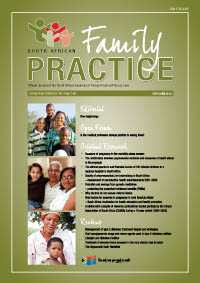Outcome of Pregnancy in the Morbidly Obese Woman
Keywords:
morbid obesity, pregnancy, epidural, caesarean section, diabetes.
Abstract
Background: Obesity is a growing global health problem. In South Africa, more than half of the adult women are overweight and almost 30% obese. The problems associated with obesity such as diabetes, hypertension, thrombo-embolism and coronary heart disease are well described in the non-pregnant population, but the condition itself holds specific risks during the ante-, intra- and postpartum periods of the pregnant woman. Of particular concern is the intrapartum period. Complications such as slow progress during labour and increased rates of caesarean section are best addressed proactively. For this reason certain sources advocate that all morbidly obese women be referred for evaluation of the pregnancy and planning of labour and delivery by an anaesthetist and a specialist obstetrician. The aim of this study was to determine whether morbidly obese women are at increased risk of adverse outcomes, compared to women with a normal body mass index. Methods: A case – control study design was used. In this study a normal body mass index (BMI) was defined as 20 –25 kg/m2 and morbid obesity as a BMI 40 kg/m2. The BMI was calculated from the weight and height measured at the booking visit. The cases in this study comprised the first 100 morbidly obese women seen at the Obstetric Special Care Clinic, in Tygerberg Hospital (TBH), a secondary and tertiary referral centre. The controls (n = 209) were women with normal BMI’s and singleton pregnancies who booked as low-risk patients at the Bishop Lavis Midwife Obstetric Unit during the same calendar period. A minimum ratio of 2:1 controls-to-case was used, with controls also matched for primi- or multiparity. Patients booking at the MOU with significant obstetric risk factors are referred to TBH for antenatal care. These women were not considered as controls. However low-risk women who met the inclusion criteria at booking and who subsequently developed risks or complications were included, as the selection was done according to findings at the booking visit. The main outcomes to be determined were: ante-, intra- and postpartum maternal complications, rate of epidurals, and perinatal outcomes. Results: Women in the morbidly obese group were significantly older (p < 0.001) and of higher parity (p < 0.001) than those with normal BMI’s. There was no difference in the numbers of primigravidae. Significantly more women in the morbidly obese group had experienced at least one miscarriage (p = 0.002). In similar fashion, significantly more of the previous deliveries in the morbidly obese group had been by caesarean section (p < 0.001). Again, significantly more of women in the morbidly obese group had previously experienced pregnancies complicated by hypertension ( p < 0.001). In the index pregnancies studied, morbidly obese women experienced more hypertension (p < 0.001), diabetes (p = 0.02) and urinary tract infections (p < 0.001) than controls. They underwent induction of labour more often (p < 0.001) and had a higher rate of caesarean delivery (p < 0.001). Epidural anaesthesia was planned for all morbidly obese patients, but only 14% received it. During delivery, perineal damage was more common in morbidly obese women (p < 0.001) and their babies were significantly larger (p < 0.001). There was one perinatal death. Conclusions: Morbidly obese women experienced increased complications during pregnancy and childbirth. Due to the high rate of caesarean sections and the potential difficulties of emergency anaesthesia amongst these women, epidural anaesthesia during labour should be planned and administered as often as possible.
Published
2008-12-12
Section
Original Research
By submitting manuscripts to SAFP, authors of original articles are assigning copyright to the South African Academy of Family Physicians. Copyright of review articles are assigned to the Publisher, Medpharm Publications (Pty) Ltd, unless otherwise specified. Authors may use their own work after publication without written permission, provided they acknowledge the original source. Individuals and academic institutions may freely copy and distribute articles published in SAFP for educational and research purposes without obtaining permission.

